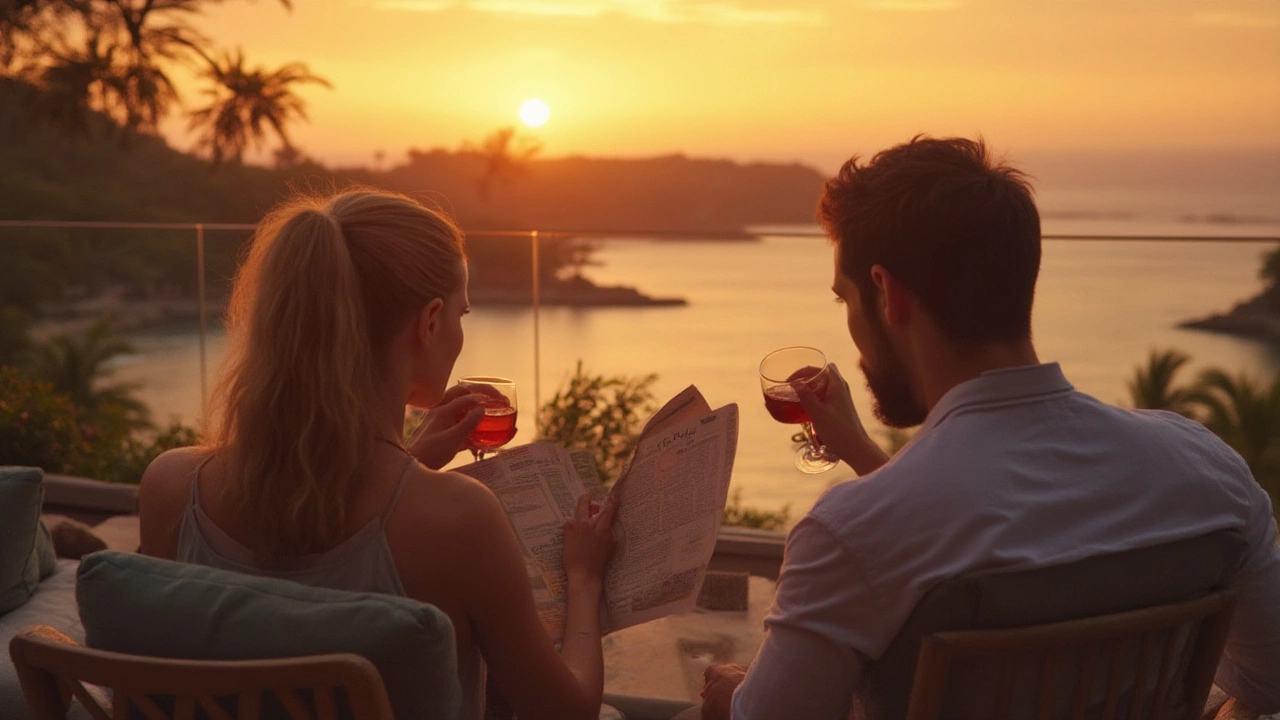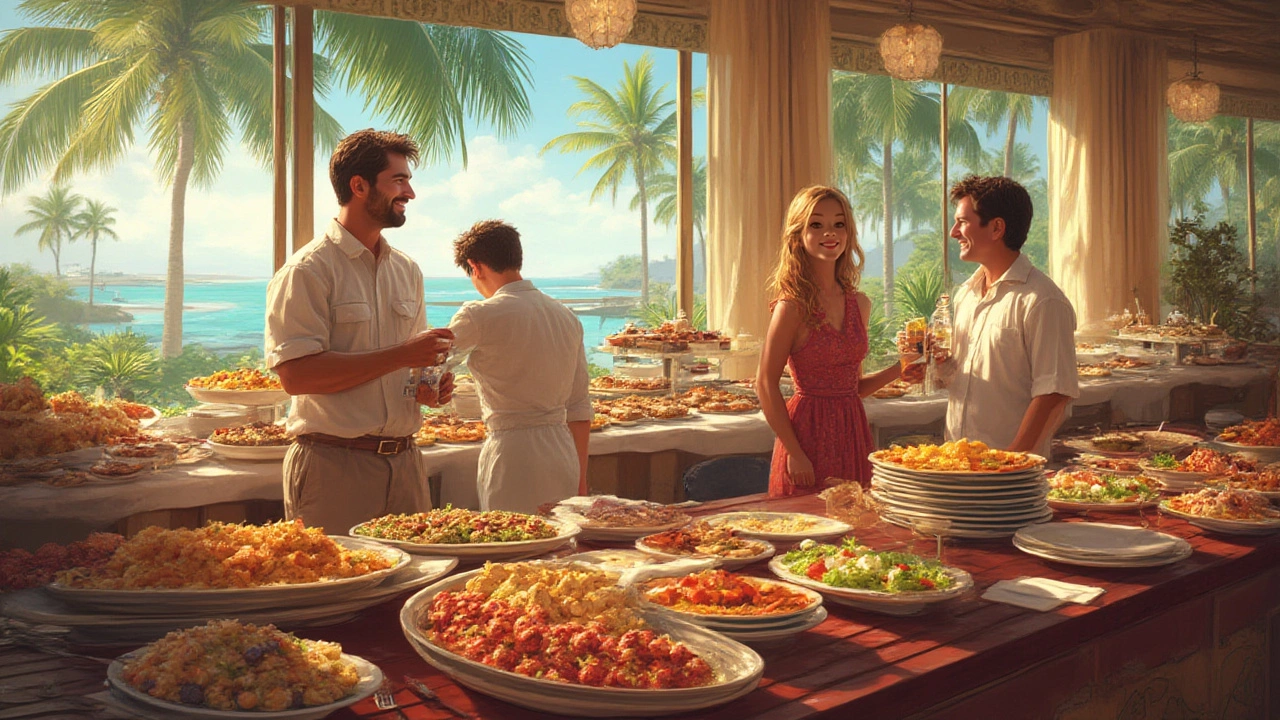Picture this: You’re lounging by a turquoise pool, sun hat slipping over your eyes, drink in hand—and the best part? You don’t have to think about a bill landing on your sunbed. The draw of all-inclusive travel isn’t just the endless sunshine, the epic ocean views, or the perfectly fluffed pillows. It’s the promise in those two little words: all-inclusive. But what does that really mean for your plate and your glass? Does all-inclusive mean all you can eat and drink, or is there some fine print lurking beneath all those umbrella cocktails?
How 'All-Inclusive' Packages Are Marketed
The words ‘all-inclusive’ have a certain magic. They're splashed across brochures and websites, beckoning us with the vision of endless choices. But here’s the thing—the phrase can mean very different things depending on where you book. Some resorts really go for it, letting you eat and drink without a second thought (or extra charge). But there are plenty of places that tuck all kinds of limits into the small print. For example, Club Med, which pretty much launched the concept back in the 1950s, aims to cover everything from food to activities. Fast forward to today, and you’ll find chains from Sandals to RIU promising virtually the same. But check out the terms: Sandals focuses on specialty restaurants and top-shelf spirits. Yet, even they may offer some “premium” wine or fine dining that’s not part of the package.
One Caribbean travel survey from 2023 showed that 74% of guests at big-name all-inclusive resorts found at least one menu item or drink not included in their initial booking. What does that look like in practice? Picture steakhouse nights that cost extra, "gourmet" gelato bars tucked away behind paywalls, or a certain whiskey that's only available for upgrade. If you’re the kind of traveler who expects total freedom—ordering three entrees or switching from poolside daiquiris to an after-dinner espresso martini just because—you’ll want to get the details. Resorts in Spain and Mexico, for instance, often include buffets and local spirits, but a fancy steakhouse or international brand might come with a tab. If there’s one tip to take away here, it’s this: always read the inclusions list before you book or ask the property for specifics. No one likes a vacation surprise that feels more like a trick than a treat.
Eating at All-Inclusive Resorts: What Can You Really Expect?
Food might be the main character in the all-inclusive story. You see glossy ads with crowded buffets and freshly grilled fish, but the reality is more nuanced. Nearly every resort covers breakfast, lunch, dinner, and snacks, usually across one or more buffet restaurants. That’s fantastic for families who need flexibility and variety. And honestly? The buffet format is a logistical marvel. Some places—like Iberostar or Hyatt Zilara properties—offer late-night taco stands or crêpe carts by the pool, just because they can.
But all-inclusive doesn’t always mean unlimited gourmet experiences. Some restaurants within a resort (especially those marked ‘à la carte’) require reservations in advance. Often, there’s a limit—say, two dinners per week—especially at specialty restaurants serving sushi, steak, or Italian cuisine. Real talk: the lobster or prime rib you spotted on TripAdvisor? That might come with a surcharge, or it may only be on the menu once per week. And if you have food allergies or dietary preferences? That’s another level of planning, since buffets can be a minefield for cross-contamination. Resorts like Beaches and Club Med do a stellar job with labeling foods and offering gluten-free and vegan options, but it’s smart to communicate your needs when you book.
Another twist? Room service. Some places include it, letting you snack on club sandwiches at midnight with zero guilt. Others charge a "tray fee" or only allow it during limited hours. If this is a dealbreaker, check before you pack those pajamas. By the way, here’s another little-known tip: Some all-inclusives swap daily lunch or dinner for packed picnic baskets if you’re off on an excursion—so you never go hungry, even off-property. Here’s a useful snapshot comparing typical food policies at three leading all-inclusive resort chains:
| Resort Group | Buffet Meals | À la Carte Restaurants | Room Service |
|---|---|---|---|
| Sandals | Unlimited | Unlimited (reservation may be needed) | Included 24/7 |
| RIU | Unlimited | Limited per stay (usually 1-3 times) | Not always included |
| Beaches | Unlimited | Unlimited, no reservations | Included (hours vary) |
So before you dream of eating your body weight in sushi or pasta, get that fine print checked—and maybe jot down a few on-property restaurant names for later.

What About Drinks? Unlimited or Not?
The image of all-inclusive usually means there’s a pina colada waiting for you before you even unpack. Most resorts really do cover a wide selection of cocktails, beer, wine, and soft drinks in their base package. You can order at swim-up bars, beach shacks, poolside waiters, or even lobby bars. But, and here comes the plot twist, not every libation makes the cut. Local, domestic, or “house” brands come standard, but if you want that bottle of aged rum or a single malt whiskey, there’s often a premium—and, at some places, a steep one!
The drinks situation varies widely between regions, too. At many Caribbean resorts, you’ll get local beer and spirits without hesitation. Want something like Grey Goose or Don Julio? Ask for the top shelf, but expect a charge unless you’re at a super high-end spot like Grand Velas or Excellence Playa Mujeres. Iberostar’s 2023 guest survey in Mexico found that 82% of guests who ordered "international branded spirits" were told they’d need to pay extra. Even sodas and specialty coffees can slide into "premium" territory at some properties.
Mini-bars in your room? That’s another question mark. Some places restock them for free every day, filling it with beer, soft drinks, and snacks. Other resorts might only give you a bottle of water and a couple of sodas, with any refills costing extra. Keep an eye on this if you like mixing your own G&T at sunset. For a quick-glance breakdown, here’s a table showing how drink inclusions differ between some popular resort chains:
| Resort Chain | Local Spirits | International Spirits | Mini-Bar Inclusions |
|---|---|---|---|
| Excellence | Unlimited | Most included | Refilled daily, free |
| RIU | Unlimited | Limited, surcharge applies for premium | Limited, basics only |
| Iberostar | Unlimited | Pay by the shot for premium brands | Water/sodas restocked daily |
If a big part of your vacation joy is sampling different wines, beers, and fancy cocktails, double-check the bar list online. And don’t be shy about asking for the drink menu as soon as you sit down. If your resort does charge a premium for certain drinks, it’s usually noted on a separate part of the menu.
“The definition of an all-inclusive holiday can change from one resort to another. Travelers need to check exactly what is covered in the package to avoid disappointment,” advises Sarah Harris, editor at Travel Weekly.
Not All 'All-Inclusive' Deals Are Created Equal
Here’s where things get really interesting. Terms like ‘ultra all-inclusive,’ ‘premium all-inclusive,’ and ‘family all-inclusive’ are popping up everywhere. One isn’t automatically better—they just focus the package a bit differently. ‘Ultra’ usually means you might get more international name-brand liquors and a wider restaurant choice. ‘Premium’ often covers things like spa credits or off-property activities, on top of food and drinks. But that doesn’t guarantee zero upcharges.
Let’s talk about sneaky exclusions. Sometimes bottled water (yes, really), sparkling wines, specific cocktails, or child-friendly juice bars aren’t included. That’s why you’ll sometimes hear people grumble that all-inclusive didn’t feel truly all-in. In Europe, for instance, tax laws have even affected all-inclusive plans. Since 2023, some Spanish islands restrict the number of alcoholic beverages included in all-inclusive packages to curb excessive drinking, limiting guests to six drinks per day. Suddenly, “unlimited” really isn’t—unless you want to pay.
Consider this real scenario: At a resort in Majorca, guests were stunned to learn about a daily drink cap, enforced by special wristbands that tracked purchases. So, even if the buffet never ends, your poolside happy hour might. Another wrinkle: some all-inclusives cover food and soft drinks only, especially at eco-friendly or wellness resorts, where alcohol is off the menu or limited for health reasons.
Here’s a quick list of what’s commonly included, and what isn’t, at most mainstream all-inclusive resorts worldwide:
- Included: Buffet meals, snacks, most non-alcoholic drinks, local beers and spirits, standard cocktails, soft drinks, specialty coffees (sometimes)
- Not always included: Premium wines/spirits, fine dining restaurants, bottled water, energy drinks, room service (24/7), minibar restocking, specialty desserts/ice cream
- Always extra: Spa treatments, off-site excursions, airport transfers, private dinners, certain water sports, golf/tennis lessons
The takeaway? The definition of all-inclusive isn’t always universal. A little homework upfront saves a lot of wallet shock at checkout.

How to Get the Most from Your All-Inclusive Experience
If you want your vacation to live up to those glossy brochure promises, a bit of planning goes a long way. Start by reading the resort’s website carefully—not just the headlines, but the tiny footnotes and FAQ sections. It sounds basic, but many travelers have been sideswiped by unexpected surcharges that could have been spotted with a quick look at the “terms and conditions.”
Want to really maximize your all-inclusive stay? Here’s what I tell my friends before every trip:
- Check if specialty dining restaurants require advance reservations, and book as soon as you check in—or before.
- Take a photo of the in-room mini-bar. If anything disappears, you’ll have proof for the desk if you’re billed for a restock.
- Ask about the resort’s drink list at check-in—and look for menus with premium charges clearly marked.
- If you love coffee, check if specialty coffee bars (lattes, cold brew) are included or extra. Some brands—like Royalton—charge for barista drinks outside the buffet.
- Traveling with dietary restrictions? Email the resort at least a week before you arrive and ask for details about safe allergen-friendly options.
- Use the resort’s official mobile app (if they have one). Many now show daily menus, opening hours, and the drinks menu live—so you’re not wandering from restaurant to restaurant trying to find that one open snack bar.
- Check reviews on recent travel forums for hidden extras. Guests tend to post about any surprise charges or stand-out experiences, good or bad.
And here’s a final pro tip: If a certain food or drink is really important to you, like a specific whiskey or vegan sushi, pack flexible expectations and maybe a backup snack for the in-between. Even with the quirks, all-inclusive resorts are designed to minimize stress and maximize fun. If you don’t feel like doing the math every time you order a mojito, stick to the mainstream brands or the house recommendations—they’ll almost always be included. And don’t forget to tip your favorite bartender (unless local rules say otherwise). It can mean the difference between a lukewarm margarita and a next-level frozen daiquiri.

